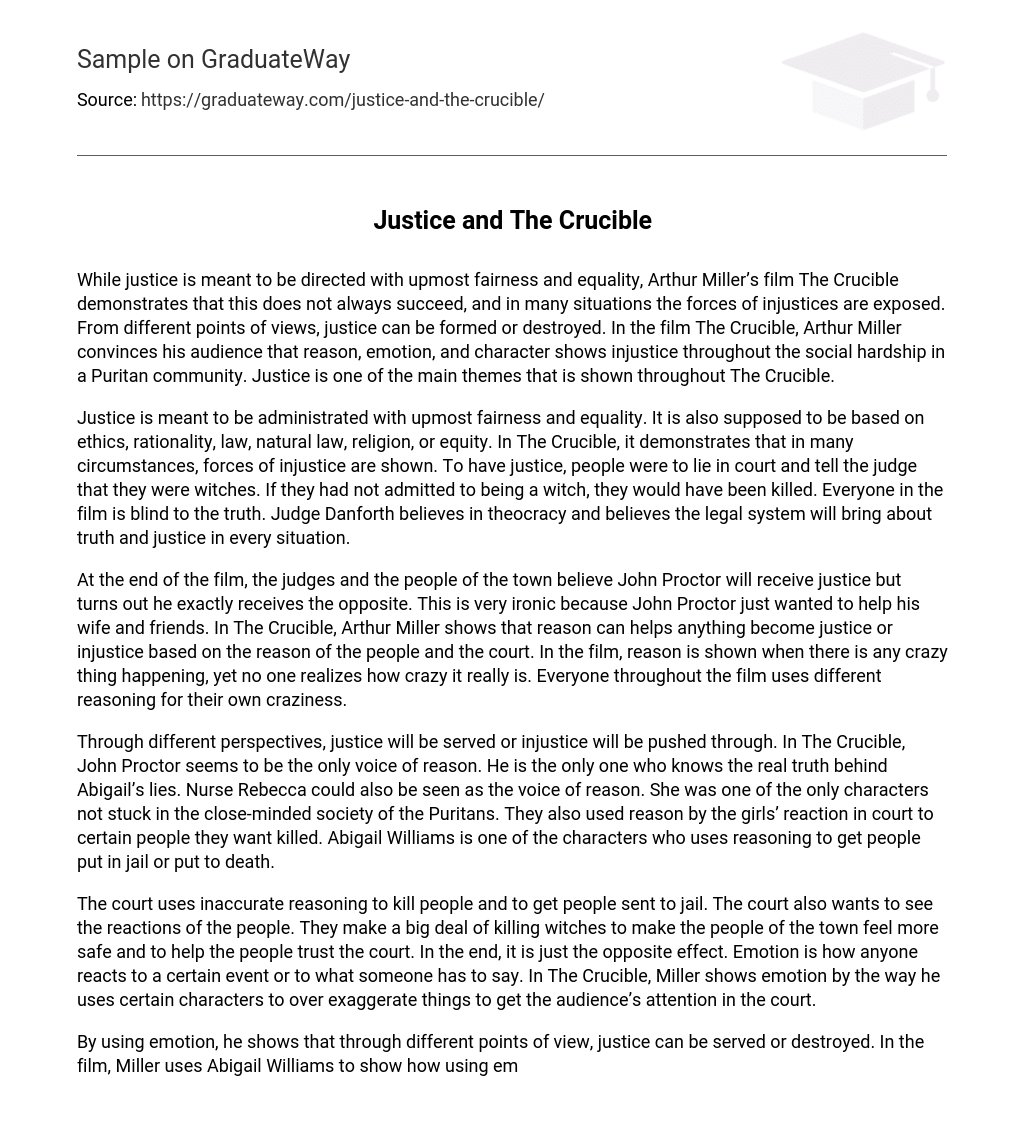Despite the intended purpose of justice to be impartial and equitable, Arthur Miller’s film The Crucible reveals the inherent flaws in achieving this, as various instances highlight the presence of unjust forces. The film convincingly depicts how reason, emotion, and character expose injustice within the challenging social circumstances of a Puritan community. Justice emerges as a prominent theme throughout The Crucible.
The text underscores the significance of justice and the necessity for it to be dispensed impartially and inclusively. It should rest upon foundations such as ethics, rationality, law, natural law, religion, or equity. The Crucible illustrates scenarios characterized by prevailing injustice. To attain justice, individuals are compelled to perjure themselves in court and falsely confess to practicing witchcraft. Refusal to comply culminates in their demise. The movie’s characters remain oblivious to the truth. Judge Danforth ardently believes in theocracy and places unwavering faith in the legal system’s ability to establish truth and administer justice under any circumstance.
In the film “The Crucible,” the judges and townspeople anticipate that John Proctor will be treated fairly and justly, but they are proven wrong. This irony arises as Proctor’s intention was simply to assist his wife and friends. Arthur Miller, through “The Crucible,” illustrates that justice or injustice can be influenced by people’s reasoning and the court’s judgment. The film demonstrates instances of reason when absurd events occur, yet no one perceives their true absurdity. Each character in the film employs diverse reasoning to justify their own bizarre actions.
The Crucible showcases different perspectives on justice, with outcomes ranging from serving justice to pushing through injustice. John Proctor emerges as the sole voice of reason, being the one who knows the actual truth behind Abigail’s lies. Nurse Rebecca can also be perceived as a voice of reason, as she is not trapped in the close-minded society of the Puritans like most characters are. Moreover, the girls in court react in a calculated manner to certain individuals, displaying their own form of rationality. Abigail Williams is another character who employs reasoning tactics to incriminate and imprison others.
The court’s use of faulty reasoning to carry out executions and imprison individuals is accompanied by a desire to observe people’s reactions. Executing witches is deemed crucial for instilling a sense of safety in the town’s residents and building trust in the judicial system, although this approach ironically has adverse consequences. Emotion refers to individuals’ responses to events or words. In The Crucible, Miller employs certain characters as tools for manipulating emotions, accentuating particular aspects, and captivating the courtroom audience.
Through various perspectives, Miller illustrates the influence of emotion in serving or undermining justice. In his film, Miller employs the character of Abigail Williams to exemplify how manipulating emotions can enable individuals to achieve their desires. Abigail deliberately amplifies situations beyond reality to elicit heightened responses from both the spectators and the judges. During court proceedings, she and her fellow sisters employ tactics to captivate the audience, feigning visions and portraying themselves as victims of torture in order to incriminate others.
The court sympathizes with Abigail, convincing them that imprisoning and executing the convicted “witches” will achieve justice. However, those accused of witchcraft disagree, believing that true justice is not served. The Crucible also explores the idea of character, how individuals display their qualities and morals to define themselves. In the movie, a person’s character can falsely lead others to believe they are a witch. This representation of character is considered unjust and unethical.
In The Crucible, Miller uses characters to illustrate that being different can lead to accusations of witchcraft. For instance, Giles Corey’s mere inquiry about someone’s day coincided with a sudden outbreak of fire, causing people to view him as suspicious and ultimately label him as a witch. This lack of justice is evident, as true justice is supposed to be impartial and fair. The court’s unjust nature becomes apparent when individuals are judged based on their character rather than actual evidence. In the town, having a questionable character significantly increased the likelihood of being accused and charged as a witch.
The Crucible by Arthur Miller explores the importance of character in identifying witches. It illustrates how character influences the portrayal of injustice through reason, emotion, and character itself. In the town depicted in the play, justice is supposed to ensure equality and fairness. However, it is ultimately up to the court’s verdict to determine what is considered just or unjust. This results in various interpretations of events; some view them as fair while others criticize them as biased.
Works Cited
“The Crucible” is a movie based on Arthur Miller’s screenplay and directed by Nicholas Hytner. Twentieth Century Fox produced the film, starring Daniel Day-Lewis and Winona Ryder in leading roles. The DVD release of the movie occurred in 1996.





